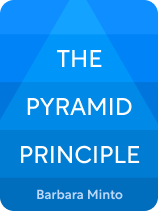

This article is an excerpt from the Shortform book guide to "The Pyramid Principle" by Barbara Minto. Shortform has the world's best summaries and analyses of books you should be reading.
Like this article? Sign up for a free trial here.
What makes writing bad? What should you be avoiding when you write?
In The Pyramid Principle, Barbara Minto argues that conclusions-last writing overburns readers in two ways. Writing conclusions last makes reading more effortful and time-consuming, and it confuses readers.
Let’s explore these two problems further and illustrate why they can make your writing bad.
Problem 1: Conclusions-Last Writing Makes Reading More Effortful
What makes writing bad? First, Minto argues that conclusions-last writing requires readers to expend time and energy forming conclusions as they read. When a writer doesn’t supply a conclusion up front, the reader defaults to their natural tendency of generating a conclusion themselves. This is a higher-order thinking skill that requires mental energy and slows down the reading process.
(Shortform note: Research supports Minto’s idea that it’s mentally taxing for readers to formulate their own conclusions. To formulate your own conclusions about a set of information, you engage in synthesis, a complex thinking process. When you synthesize, you summarize the information you read and use it to construct new meaning. Synthesis is a more complex and cognitively demanding thinking process compared to comprehension, which simply involves understanding information. A reader who encounters a conclusion at the beginning of a written piece can focus on comprehending the author’s conclusions, whereas a reader engaging with conclusions-last writing must expend mental energy synthesizing the author’s conclusions.)
Problem 2: Conclusions-Last Writing Creates Confusion
Second, according to Minto, conclusions-last writing can confuse readers. The conclusion that the reader forms as they read may differ from the author’s conclusion. When the reader finally encounters the author’s conclusion and notices it’s different from their own, they’ll likely become confused.
(Shortform note: Although Minto implies that you should avoid confusing your readers, research reveals that in some circumstances, confusion can actually improve people’s learning. When something you’re learning makes you confused, you become motivated to relieve that confusion. This motivation can deepen your engagement with the content and improve your memory of it. However, confusion only promotes learning and retention when learners have the skills and time to persist through that confusion. For instance, a reader with strong reading skills and the time to re-read may benefit from the confusion of conclusions-last writing. By contrast, someone with weaker reading skills or less time to re-read may not benefit from confusion.)
Example: A Conclusions-Last Opinion Piece
Let’s illustrate these two problems by considering this example of writing: “My workplace hosts a monthly, mandatory community-building lunch for employees. Some people arrive in high spirits because these lunches help them feel connected to others. Others arrive grumpy and stressed because they believe these lunches cut into their valuable work time.” (Note: This example omits the conclusion entirely.)
Most readers will automatically expend mental energy and time trying to find the similarities among these three sentences and summarize them into a conclusion. For instance, a reader might form this conclusion: “The writer is upset that some of their coworkers bring a negative attitude to work lunches.” Contrast this with the writer’s actual conclusion: “Some workplaces’ efforts to reduce employee burnout backfire when they make community-building activities mandatory.” Because the writer didn’t express this conclusion at the start of their paragraph, the reader interpreted the paragraph in a different way than the author intended. This lack of clarity could leave the reader feeling confused.

———End of Preview———
Like what you just read? Read the rest of the world's best book summary and analysis of Barbara Minto's "The Pyramid Principle" at Shortform.
Here's what you'll find in our full The Pyramid Principle summary:
- How to write so clearly that you can get a point across within 30 seconds
- How to write a clear, compelling introduction, body, and conclusion
- Why you should always start your prose with your conclusion and work backward






